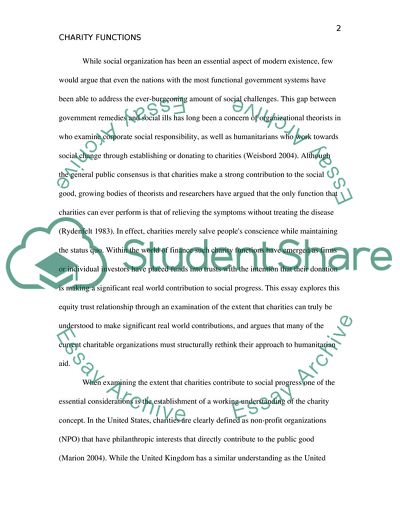Cite this document
(Charity Functions Essay Example | Topics and Well Written Essays - 2000 words, n.d.)
Charity Functions Essay Example | Topics and Well Written Essays - 2000 words. https://studentshare.org/law/1768520-it-has-been-argued-that-the-only-function-that-charities-can-ever-perform-is-that-of-relieving-the-symptoms-without-treating-the-disease-in-effect-charities-merely-salve-peoples-conscience-while-maintaining-the-status-quo-discuss
Charity Functions Essay Example | Topics and Well Written Essays - 2000 words. https://studentshare.org/law/1768520-it-has-been-argued-that-the-only-function-that-charities-can-ever-perform-is-that-of-relieving-the-symptoms-without-treating-the-disease-in-effect-charities-merely-salve-peoples-conscience-while-maintaining-the-status-quo-discuss
(Charity Functions Essay Example | Topics and Well Written Essays - 2000 Words)
Charity Functions Essay Example | Topics and Well Written Essays - 2000 Words. https://studentshare.org/law/1768520-it-has-been-argued-that-the-only-function-that-charities-can-ever-perform-is-that-of-relieving-the-symptoms-without-treating-the-disease-in-effect-charities-merely-salve-peoples-conscience-while-maintaining-the-status-quo-discuss.
Charity Functions Essay Example | Topics and Well Written Essays - 2000 Words. https://studentshare.org/law/1768520-it-has-been-argued-that-the-only-function-that-charities-can-ever-perform-is-that-of-relieving-the-symptoms-without-treating-the-disease-in-effect-charities-merely-salve-peoples-conscience-while-maintaining-the-status-quo-discuss.
“Charity Functions Essay Example | Topics and Well Written Essays - 2000 Words”. https://studentshare.org/law/1768520-it-has-been-argued-that-the-only-function-that-charities-can-ever-perform-is-that-of-relieving-the-symptoms-without-treating-the-disease-in-effect-charities-merely-salve-peoples-conscience-while-maintaining-the-status-quo-discuss.


